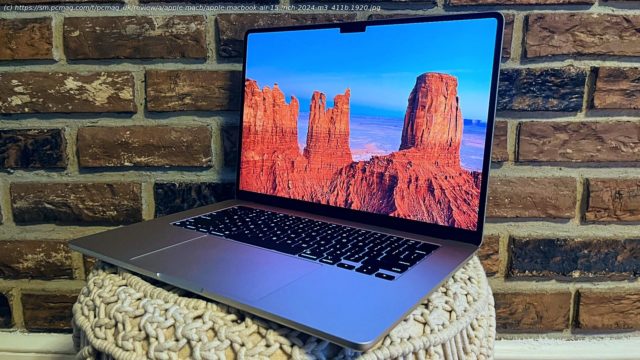Apple’s bigger Air, made better with M3 might
Less than a year after the first 15-inch MacBook Air debuted, its successor has landed in a redefined laptop market, with fresh competition from Intel-based desktop replacements. Now with Apple’s latest M3 processor, the 2024 MacBook Air 15-Inch (starts at $1,299; $1,699 as tested) is a no-doubter improvement that opens up new capabilities for the laptop, which alone makes the case for this Air maintaining its Editors’ Choice award. Intel’s new Core Ultra (“Meteor Lake”) chips are already putting up a hearty fight in like-configured products, some more affordable than the 15-inch Air model we tested. But the combination of design and muscle make the new Air just as compelling as the old. Owners of the first 15-inch Air shouldn’t fear missing out, but the latest model will please at-home digital hobbyists, students, and even some office workers who have yet to hop aboard the big Air train. (See also our review of the 13-inch M3 version of the Air, debuting alongside this new 15-incher.)Configurations and Design: Apple Focuses Inward on Silicon
With the M3 15-inch MacBook Air, Apple is focused on catching it up with its latest silicon…and little else. Considering how much the modern MacBook Air design achieves, that’s not a problem, but this could have been an opportunity for the 15-inch model to make more use of its extra space for an SD card slot or some additional connections not present on the first-gen model. (And, for those whom it offends, address the webcam notch in the 15.3-inch Liquid Retina display.)
Every facet of the M3 15-inch MacBook Air’s design is identical to the previous generation: It’s quite literally the same chassis, but with a beefier processor inside. See our Apple MacBook Air 15-Inch (2023) review for a longer look at the new Air design blown up to 15 inches.
However, since this is my first time handling a 15-inch MacBook Air, I’ll have fresh impressions of the new size to share below.
As for how the 15-inch MacBook Air can now be configured before checkout, not much has changed in that way, either. Just like before, the 15-inch MacBook Air starts at $1,299, which now gets you the base M3 processor (the version with the eight-core CPU and 10-core GPU), 8GB of unified memory, and a 256GB solid-state drive.
The unit I was sent for review is a step up from here, doubling both the memory and the storage (to 16GB and 512GB, respectively) for $1,699. You’ll find a model in between that doubles the storage, but not the memory, for $1,499.
Of course, you can also upgrade your model piecemeal from the checkout menu. Done this way, memory upgrades cost $200 for 16GB, and an even steeper $400 for 24GB. Storage upgrades are priced in the same $200 increments, starting with $200 for 512GB and rocketing to as much as $800 for 2TB of space. All told, a maxed-out 15-inch MacBook Air tops out at $2,499—and at this price point, you should seriously consider whether a MacBook Pro would better serve your needs.Using the 2024 Apple MacBook Air 15-Inch: Bigger and Better, But Somehow Not Bulkier
Immediately upon unboxing the new 15-inch MacBook Air, I was admittedly surprised by how wafer-like it felt for its 15-inch size, like a stuffed binder. Laptop makers on the other side of the wall have achieved a similar experience, like LG in the Gram Pro 17, but not nearly as sturdy and well-built.
Now that I’ve felt and worked with it for a few days, a big-screen Air makes a lot of sense, especially when you get 15.3 inches of screen space out of a laptop that’s just 13.4 inches across. Carrying around the larger Air feels similar to the 14-inch MacBook Pro, splitting the difference in size and hardware inside.
However, the presence of the FaceTime camera notch is more noticeable on a larger screen, particularly pronounced in full-screen videos and games. Surely, without any Face ID hardware inside, a better way to do this exists? A tech nerd can dream. At any rate, I appreciate the shift to 1080p webcams at last.
Regardless, the display is downright gorgeous, with excellent contrast and plenty of brightness aside from its super-sharp resolution. Notch or not, watching videos is way more satisfying on this Air than any I’ve tested before. The additional screen space is also helpful for multitasking without an external display.
By the way, thanks to the M3 processor, the new MacBook Air models can power two external displays over its two Thunderbolt 4 ports at once. However, the laptop needs to be closed while it does this—a limitation not found on MacBook Pro models with the M3 Pro or M3 Max chips.
Everything else about the 15-inch MacBook Air design is the same as before, and it’s fine to lean into a look and feel that’s been received well, at least for a little bit. The keyboard and touchpad are both a joy to use, and the key backlighting is excellently uniform and bright. Likewise, the Touch ID power button key is speedy to respond and pleasantly simple to use.
However, with its clear media-editing chops (which we’ll get into in our testing analysis below), this was again an opportunity to mildly tweak the 15-inch Air design to include an SD card slot. (A USB-C port is a bit thicker than an SD card slot, after all.) Testing the 2024 Apple MacBook Air 15-Inch: Apple’s Big-Screen Midranger Swims Upstream
Before getting into the benchmark results and competitive performance comparisons, I should note that because of the limited time we had before publishing, we do not yet have formal display-testing results. These will be added as soon as we’re able to get this MacBook in front of a colorimeter in PC Labs.






